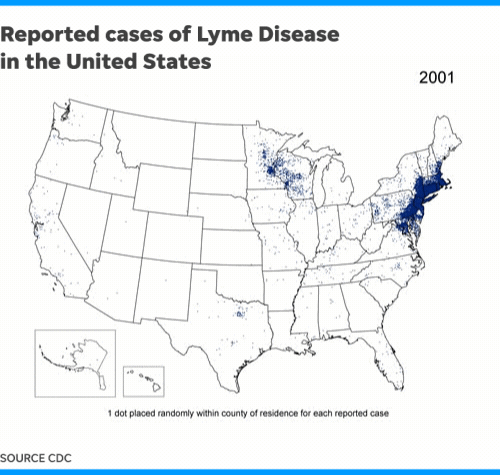Tests for Lyme disease don't work well enough to diagnose illness early, federal panel says
 Jerry Carino
Jerry Carino
Although the number of reported new Lyme disease cases has averaged fewer than 25,000 for the past decade, a federal working group convened to address tick-borne illnesses contends that the actual number is 10 times greater and recommends developing a better test for discovering the bacterial infection.
The 100-page report to Congress, the first of three in a four-year period, is crucial because it represents consensus on how to deal with Lyme after decades of disagreement among government officials and medical experts.
The discord has caused an explosion of cases throughout the country – from fewer than 13,000 about 20 years ago in New England to nearly 30,000 in 2017, the latest information available – advocates for Lyme patients say.
“It’s a good first step,” said Pat Smith of Wall Township, New Jersey, a member of the 14-person working group. “Hopefully, we will break this gridlock that we have on Lyme disease."
► Aug. 16:Brown dog ticks sparked a fever epidemic in Mexico. U.S. may be next.
► Aug. 7:Health officials sound alarm as invasive tick, new to U.S., spreads
► July 12:First death from Rocky Mountain spotted fever in Wisconsin confirmed
Lyme disease has been around for thousands of years, but in the United States it first was recognized in 1975 in a cluster of children and adults around Lyme, Connecticut, who were having arthritis-like symptoms. In 1982, researchers discovered that infected blacklegged ticks transmitted the Borrelia burgdorferi bacterium to humans, causing an infection with fever, headache and fatigue that can spread to joints, the heart and nervous system if left untreated.
"Patients are still having difficulties, and doctors are having problems trying to treat them," she said. "I hope this will be an eye-opener for Congress.”

In the 1980s, the infection afflicted two of Smith's daughters, one of whom missed four years of school. She founded the nonprofit Lyme Disease Association and has traveled the country to raise awareness.
"Now the big question is, what is Congress going to do in light of these recommendations?” she said.
Because of the difficulty testing for the bacteria that cause Lyme disease – false positives and false negatives are common – the working group said additional research into diagnosing all tick-borne diseases can save the country money in the long run.
► June 12:Tick paralysis: 5-year-old suddenly couldn't walk, had trouble speaking
► May 23:What you need to know about tick diseases, how to remove them
Rep. Chris Smith, R-N.J., who advocated for the group's creation, called for “a coordinated, comprehensive federal response, including more funding of research” in response to the report.
Atop the list is testing. The report outlines the shortcomings of the standard practice of testing for Lyme through “serological assays,” or blood tests that look for antibodies. This form of testing is notoriously unreliable in detecting Lyme, especially in the crucial early stages of infection.

Ten percent to 20 percent of Lyme disease patients diagnosed in the early stages experience symptoms for six months or longer after diagnosis and treatment, according to the report. Those diagnosed later may end up with chronic Lyme disease and still have problems even after the infection is cured.
The report recommends federal investment into the development of new testing techniques. It also suggests exploring specific ways to better test children, who are believed to constitute as much as half of the infected population.
► May 8:CDC apologizes for hiding ticks on a muffin to warn of Lyme disease
► May 7:Lyme disease explained: Symptoms, treatments, states where cases occur
“The most significant thing, one everyone agrees with is we need new kinds of testing for Lyme disease,” Pat Smith said. “We also need new kinds of therapeutic options for both acute Lyme and those with persistent illness.”
Another focus of the report: The national surveillance system for tracking tick-borne illness cases needs to be strengthened.
“Right now, quite frankly, it’s a mess, even (in terms of recording) what kind of ticks we're looking at in different states,” she said.
► May 2:Tick, mosquito, flea illnesses triple; U.S. not fully prepared, CDC says
► July 2017:How Lyme disease might be triggering hundreds of suicides
The report includes stories of people who suffer from tick-borne illnesses. After years of helping desperate patients cope with the horror stories of a widely misunderstood illness, Pat Smith wanted the report to reflect some of Lyme’s human toll.
“That talks about what patients are experiencing in trying to get diagnoses and treatment,” she said. “All kinds of issues are being brought to the forefront for a change.”
Follow Jerry Carino on Twitter: @NJHoopsHaven